Rocks are fundamental components of our planet, shaping landscapes and holding clues to Earth’s history. As a naturally occurring solid aggregate of minerals, rocks are categorized based on their formation processes. Understanding the types of rocks is crucial for anyone interested in geology, environmental science, or simply the world around us. This guide will explore the three primary types of rocks: igneous, sedimentary, and metamorphic, delving into their characteristics, formation, and significance.
Rocks are not static entities; they are dynamic materials constantly changing through geological processes. These changes are part of the rock cycle, a concept we will explore further. For now, let’s dive into the fascinating world of rock classification.
Igneous Rocks: Born from Fire
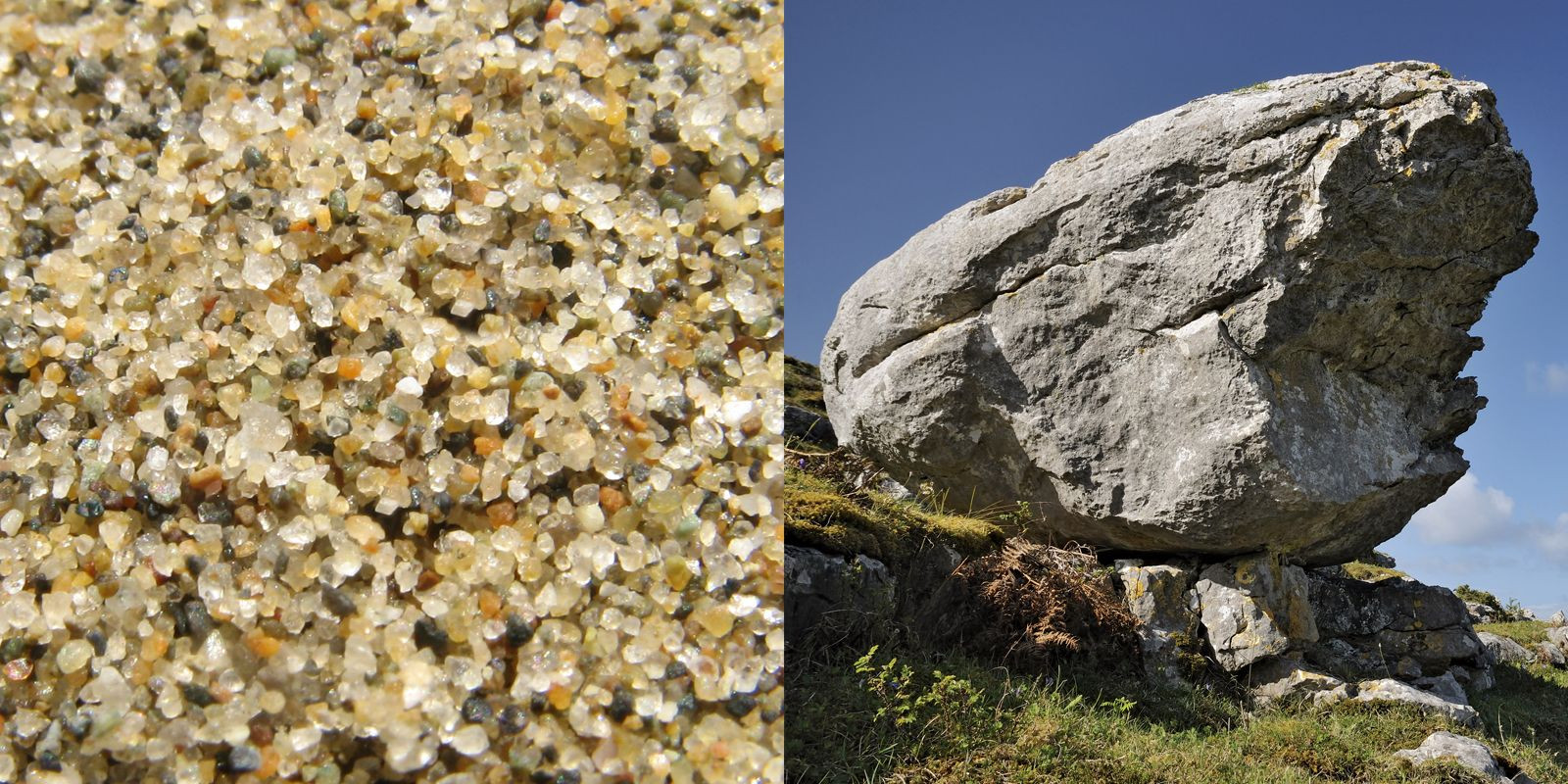 Molten lava solidifying into igneous rock
Molten lava solidifying into igneous rock
Igneous rocks, also known as magmatic rocks, are formed from the cooling and solidification of molten rock called magma or lava. This molten material originates deep within the Earth, in the upper mantle or lower crust, where temperatures are high enough to melt rock. The term “igneous” comes from the Latin word “ignis,” meaning fire, perfectly describing their fiery origin.
There are two main categories of igneous rocks, based on where the molten rock solidifies:
Intrusive Igneous Rocks (Plutonic Rocks)
Intrusive igneous rocks, also called plutonic rocks, form when magma cools and solidifies beneath the Earth’s surface. Because they cool slowly in the insulated subsurface, they develop large, visible crystals. This slow cooling allows minerals to grow to a larger size, resulting in a coarse-grained texture known as phaneritic texture. Granite is a classic example of an intrusive igneous rock, easily recognizable by its speckled appearance of different colored minerals.
Extrusive Igneous Rocks (Volcanic Rocks)
Extrusive igneous rocks, or volcanic rocks, are created when lava erupts onto the Earth’s surface or ocean floor. Because lava cools much more rapidly than magma beneath the surface, the crystals in extrusive rocks are very small, often microscopic, resulting in a fine-grained or aphanitic texture. In some cases, cooling is so rapid that crystals do not have time to form at all, creating a glassy texture, as seen in obsidian. Basalt is a common extrusive igneous rock, forming much of the oceanic crust.
Sedimentary Rocks: Layers of History
Sedimentary rocks are formed from the accumulation and cementation of sediments at the Earth’s surface. These sediments can be fragments of pre-existing rocks, mineral precipitates from solutions, or organic matter. The processes involved in forming sedimentary rocks occur at relatively low temperatures and pressures compared to igneous and metamorphic rock formation.
The formation of sedimentary rocks involves several key steps:
- Weathering and Erosion: Existing rocks are broken down into smaller pieces (sediments) through weathering (physical and chemical breakdown) and erosion (transportation of weathered material).
- Transportation: Sediments are moved by agents like water, wind, ice, and gravity to a new location.
- Deposition: Sediments settle out of the transporting medium and accumulate in layers.
- Lithification: The loose sediments are compacted by the weight of overlying layers, and then cemented together by minerals precipitating from water, forming solid rock. This process is called lithification.
Sedimentary rocks are often characterized by their layered appearance, known as stratification. These layers can reveal a timeline of Earth’s history, with each layer representing a different period of deposition. Fossils are also commonly found in sedimentary rocks, providing invaluable records of past life on Earth.
Sedimentary rocks are further classified based on the type of sediment they are composed of:
Clastic Sedimentary Rocks
Clastic sedimentary rocks are formed from fragments of other rocks and minerals. Examples include:
- Sandstone: Composed mainly of sand-sized grains of minerals like quartz.
- Shale: Made from fine-grained clay and silt particles.
- Conglomerate: Consists of larger, rounded gravel-sized rock fragments cemented together.
- Breccia: Similar to conglomerate, but with angular rock fragments.
Chemical Sedimentary Rocks
Chemical sedimentary rocks form from minerals that precipitate out of solution, often from evaporating water. Examples include:
- Limestone: Primarily composed of calcium carbonate, often formed from the remains of marine organisms or precipitation from seawater.
- Rock Salt (Halite): Forms from the evaporation of saline water.
- Gypsum: Another evaporite mineral, forming in similar environments to rock salt.
Organic Sedimentary Rocks
Organic sedimentary rocks are formed from the accumulation of organic material, such as plant or animal remains. Coal is the most common example, formed from the accumulation and compression of plant matter in swamp environments.
Metamorphic Rocks: Transformation Under Pressure
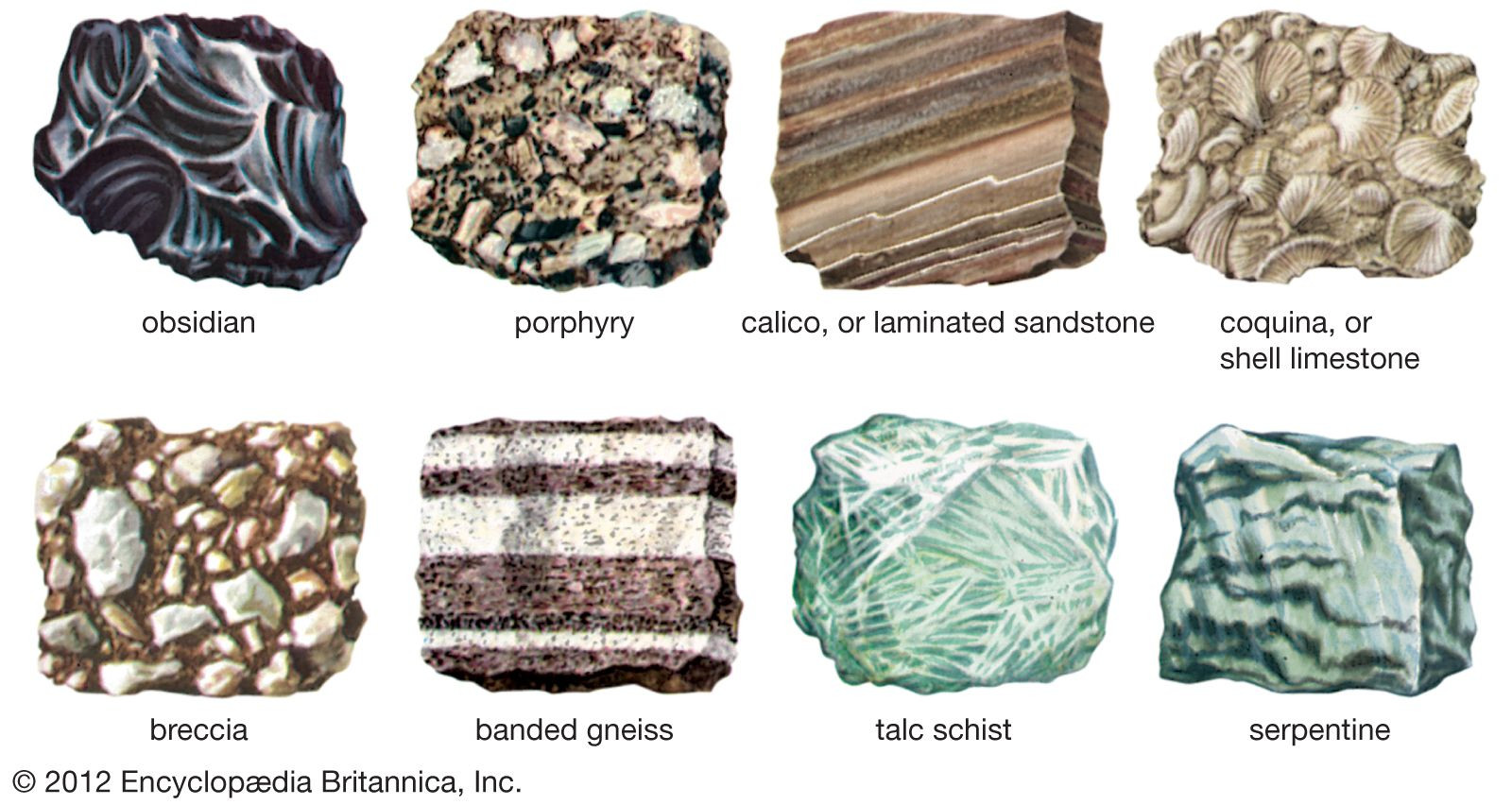 Banded texture in metamorphic rock
Banded texture in metamorphic rock
Metamorphic rocks are created when existing rocks (igneous, sedimentary, or even other metamorphic rocks) are changed by heat, pressure, or chemically active fluids. The term “metamorphic” comes from Greek words meaning “change of form.” Metamorphism occurs without melting the rock entirely; instead, the minerals within the rock recrystallize and rearrange, resulting in new textures and mineral assemblages.
The agents of metamorphism are:
- Heat: Increased temperature provides the energy for chemical reactions and recrystallization. Heat can come from burial depth, magmatic intrusions, or tectonic activity.
- Pressure: Pressure can be confining (equal in all directions) due to burial or directed (stress) from tectonic forces. High pressure causes minerals to become denser and can also align mineral grains.
- Chemically Active Fluids: Hot water and other fluids can act as catalysts for metamorphic reactions and can transport ions, altering the chemical composition of the rock.
Metamorphic rocks are broadly classified based on their texture:
Foliated Metamorphic Rocks
Foliated metamorphic rocks exhibit a layered or banded texture, resulting from the alignment of platy minerals (like mica and chlorite) under directed pressure. Examples include:
- Slate: Formed from the metamorphism of shale, known for its ability to split into thin sheets.
- Schist: Higher grade metamorphic rock than slate, with visible, platy minerals.
- Gneiss: High-grade metamorphic rock with distinct bands of light and dark minerals.
Non-Foliated Metamorphic Rocks
Non-foliated metamorphic rocks lack a layered texture. They typically form when confining pressure is dominant or when the original rock is composed of minerals that do not easily align. Examples include:
- Marble: Metamorphosed limestone or dolostone, composed primarily of calcite or dolomite.
- Quartzite: Metamorphosed sandstone, composed primarily of quartz.
- Hornfels: A fine-grained, non-foliated rock formed by contact metamorphism (heat from magma intrusion).
The Rock Cycle: An Endless Transformation
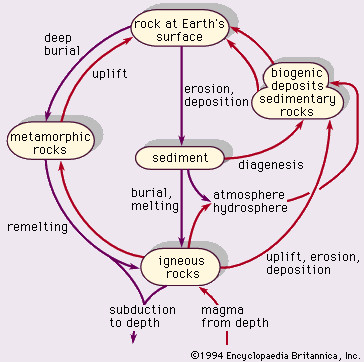 The Rock Cycle illustrating the interconnections between rock types
The Rock Cycle illustrating the interconnections between rock types
The rock cycle is a fundamental concept in geology that illustrates the continuous transformation of rocks from one type to another. It’s a series of processes that recycle and redistribute Earth materials over geological time. The three main types of rocks are interconnected through this cycle:
- Igneous rocks can be weathered and eroded into sediments, which then form sedimentary rocks.
- Sedimentary rocks and igneous rocks can be subjected to heat and pressure, transforming them into metamorphic rocks.
- Metamorphic rocks (and any type of rock) can be melted into magma, which eventually cools and solidifies to form igneous rocks, completing the cycle.
Uplift, weathering, erosion, deposition, burial, heat, pressure, and melting are all driving forces in the rock cycle. This cycle is not a simple loop; rocks can take many different pathways and spend varying amounts of time in each stage.
Rock Texture and Grain Size: Looking Closer
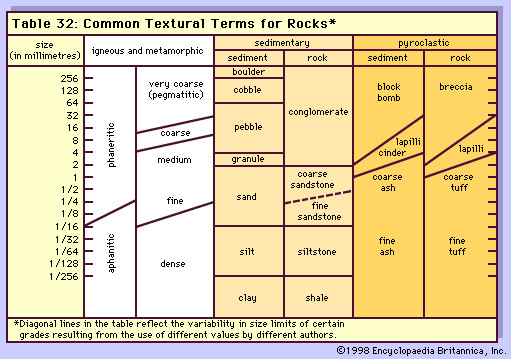 Rock texture classification based on grain size
Rock texture classification based on grain size
Beyond the three main types of rocks, geologists also classify rocks based on their texture and grain size. Texture refers to the size, shape, and arrangement of mineral grains or crystals within a rock. Grain size is a key aspect of texture, described using terms like:
- Coarse-grained (Phaneritic): Mineral grains are large enough to be easily visible with the naked eye (typically in intrusive igneous rocks and some metamorphic rocks).
- Fine-grained (Aphanitic): Mineral grains are too small to be seen without magnification (common in extrusive igneous rocks and some sedimentary rocks).
- Medium-grained: Grain size is intermediate between coarse and fine.
- Pegmatitic: Exceptionally coarse-grained, with crystals larger than 3 centimeters (often found in pegmatites, a type of igneous rock).
For sedimentary rocks, grain size classification often follows the Udden-Wentworth scale, categorizing sediments as clay, silt, sand, gravel, etc. The texture of a rock provides valuable clues about its formation history, including cooling rates, depositional environments, and metamorphic conditions.
Porosity: The Empty Spaces Within Rocks
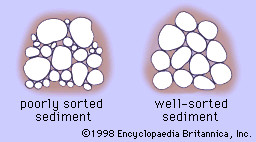 Illustration of rock porosity and sorting
Illustration of rock porosity and sorting
Porosity is another important property of rocks, referring to the volume of void space within a rock. This void space can be in the form of pores between grains, fractures, or other openings. Porosity is crucial for understanding groundwater flow, petroleum and natural gas reservoirs, and the strength and durability of rocks.
Factors affecting porosity include:
- Grain Shape and Packing: Well-rounded, uniformly sized grains that are loosely packed tend to have higher porosity.
- Cementation: Cementation reduces porosity by filling in pore spaces.
- Compaction: Compaction also reduces porosity by squeezing grains closer together.
- Sorting: Well-sorted sediments (grains of similar size) generally have higher porosity than poorly sorted sediments (grains of mixed sizes).
Understanding porosity and permeability (the ability of fluids to flow through a rock) is essential in many geological applications.
Conclusion: The Diversity of Rock Types
The three types of rocks – igneous, sedimentary, and metamorphic – represent the building blocks of our planet. Each type tells a unique story about Earth’s dynamic processes, from volcanic eruptions and mountain building to weathering and erosion. By understanding how these types of rocks form and their characteristics, we gain a deeper appreciation for the complexity and beauty of the geological world beneath our feet. Exploring the types of rocks further through resources at rockscapes.net can enhance your understanding and appreciation of these essential Earth materials.
